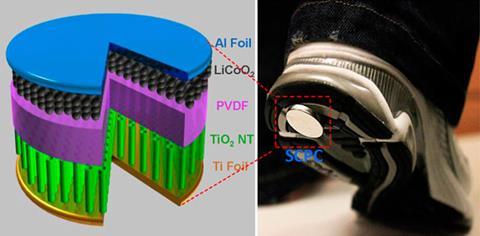
While nanomaterials that can generate electricity are the core of Wang’s research, last year his team moved into energy storage. ‘At first we were looking at a two-stage process, converting mechanical energy into electricity and then storing electricity as electrochemical energy,’ he says. ‘Then I came up with the idea: why don’t we try and do it in just one stage? Can we go directly from mechanical energy to electric energy storage?’
To do this, Wang’s team swapped the ion-permeable polythene film that usually separates the anode and cathode in a lithium ion battery for a polarised polyvinylidene difluoride (PVDF) film. In the instant they press the film, partial polarisation charges appear on its faces, creating a piezoelectric field that causes a series of rapid electrochemical changes in the surrounding power pack. The field attracts some free lithium ions through the power pack’s LiPF6 electrolyte from a conventional LiCoO2 cathode, across the membrane, into a TiO2 nanotube array anode. This provides a driving force that oxidises the cathode, releasing more lithium ions and electrons, which then reduce and are incorporated into the anode. In each depression, the charging process continues until the system reaches chemical equilibrium. Even using comparatively rigid coin-shaped packaging, Wang’s group have made cells charged this way that powered a calculator.
University of Cambridge, UK, battery material researcher Clare Grey calls these results ‘intriguing’ and says that they ‘may open up new approaches in this area’. Though Grey recognises that the one-stage process is more efficient, she warns that it restricts the kinds of materials used compared with conventional batteries. She also raises concerns over how well cells can withstand constant deformation. But the researchers recognise that they still have many questions to answer, including how many depressions a cell would take to fully charge, and what are the best anode, cathode and membrane materials. ‘This paper was just to show that it’s possible,’ Wang says.
References
- X Xue et al, Nano Lett., 2012, DOI: 10.1021/nl302879t






No comments yet